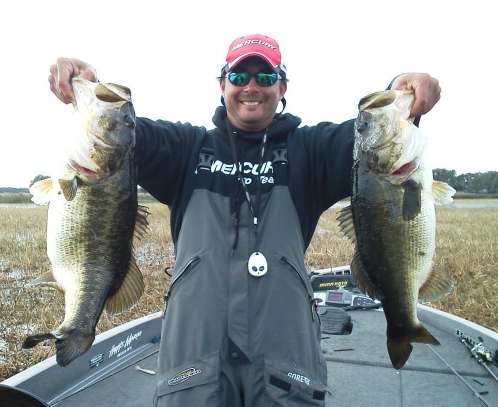
KISSIMMEE, Fla. — Florida pro Van Soles orchestrated a multifaceted strategy to win the Bass Pro Shops Bassmaster Southern Open presented by Allstate. Here are three standout keys of the win that extend beyond his basic pattern and technique.
Key #1: PowerPole as a fishing tool
The wind was all over the compass dial. Multiple cold fronts swept through the region throughout the week. Southerly and westerly breezes followed brisk north winds packing chilly air. Days included gusts up to 20 mph in all directions.
The continuously shifting winds made boat positioning a trick. Soles' fish stayed in the same general areas despite the shifting wind direction. They moved inward or outward depending on the wind.
Fundamentally, his dual PowerPole system functioned as a shallow-water anchor system as designed. In his case, the devices became a fishing tool.
The PowerPole made the wind his friend.
“They allowed me to settle down and stabilize the boat in front of the areas where I wanted to fish,” he said. “Then, I could make deliberate, specific presentations to spots without missing them.”
The PowerPole also provided a mental edge and emerged a confidence builder.
“I could reorganize my thoughts and that was a big key this week,” he continued. “I wasn’t forced into compromising any good water because of the change in wind direction.”
Making controlled drifts, missing a crucial spot altogether or having to find new water would have been the game-breaking pitfalls without PowerPole.
Key #2: Watch the weather
Soles isn’t a weather geek. As a native he does know how sensitive Florida bass are to weather changes during wintertime.
“Biologically the fish want to bed, they want to move up shallow and spawn,” he observed. “But it doesn’t take much to make them hunker down.”
He said the danger zone of water temperatures here is the 50-degree range. The fish teeter on becoming very active on the upper end of 50 and very lethargic on the low side. It was in the latter range throughout the tournament.
“Fronts pass through here rapidly and then a warming trend follows,” he added. “You’ve got to keep up with those changes and watch the weather to adjust a strategy.”
“This time of year a lot of weather changes can happen over the course of a tournament week.”
They did.
Key #3: Pitching as power fishing
Pitching is considered an extension of flipping as a finesse technique. Watch a skilled master like pro Tommy Biffle and it appears otherwise.
“I’m a power fishermen and if you fish tournaments you can’t deny that covering water is a key to winning,” he said.
Instead, Soles made a key adjustment to the mechanics of his pitching technique on the final day. It put an 8-pounder and a second fish pushing that mark on the final day in his livewell.
“Pitching by its very nature and rhythm can make you go too fast,” he said. “I recognized that and at the same time knew the fish were very lethargic.”
So he slowed down. Way down. Pitches were made about a foot apart from each other.
“That’s not easy at all when you don’t have a particular target to slow you down,” he added.
On Day Three, Soles' fish moved 6 feet beyond the edge of the dense matted hydrilla. He made pitches up to 30 feet away from the edges. That alone made a methodical presentation mandatory to be effective in landing in the strike zone.

